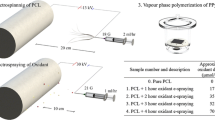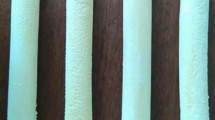Abstract
The aim of the study was to demonstrate the potential of the cryogelation technique for the synthesis of the conducting cryogel scaffolds which would encompass the advantages of the cryogel matrix, like the mechanical strength and interconnected porous network as well as the conductive properties of the incorporated conducting polymeric material, polypyrrole. The cryogels were synthesized using different combinations of oxidizing agents and surfactants like, sodium dodecyl sulfate (SDS)/ammonium persulfate (APS), SDS/iron chloride (FeCl3), cetyl trimethyl ammonium bromide (CTAB)/APS, and CTAB/FeCl3. The synthesized gels were characterized by scanning electron microscopic analysis for morphology, Fourier transform infrared spectroscopy for analyzing the presence of the polypyrrole (0.5–4 %) as nano-fillers in the gel. It was observed that the presence of these nano-fillers increased the swelling ratio by approximately 50 %. The synthesized conducting cryogels displayed high stress bearing capacity without being deformed as analysed by rheological measurements. The degradation studies showed 12–15 % degradation in 4 weeks time. In vitro studies with conducting and non-conducting cryogel scaffold were carried out to optimize the stimulation conditions for the two cell lines, neuro2a and cardiac muscle C2C12. 3-(4,5-dimethylthiazol-2-yl)-2,5-diphenyltetrazolium bromide (MTT) assay showed approximately 25 and 15 % increase in the cell proliferation rate for neuro2a and C2C12 cell line, respectively. This was observed at a specific voltage of 100 mV and 2 V, for a specified duration of 2 h and 1 min, respectively for the conducting scaffold as compared to the control. This can play an important role in tissue engineering applications for cell lines where acquiring a high cell number and functionality is desired.











Similar content being viewed by others
References
Geddes LA, Hoff HE. The discovery of bioelectricity and current electricity. The Galvani-Volta controversy. Spectr IEEE. 1971;8:38–46.
Levin M. Bioelectric mechanisms in regeneration: unique aspects and future perspectives. Semin Cell Dev Biol. 2009;20:543–56.
Pullar CE. The physiology of bioelectricity in development, tissue regeneration, and cancer. Biotechnol Prog. 2010;26:664–70.
Chao PG, Lu H, Hung CT, Nicoll SB, Bulinski JC. Effects of applied DC electric field on ligament fibroblast migration and wound healing. Connect Tissue Res. 2007;48:188–97.
Matos MA, Cicerone MT. Alternating current electric field effects on neural stem cell viability and differentiation. Biotechnol Prog. 2010;26:664–70.
Park H, Bhalla R, Saigal R, Radisic M, Watson N, Langer R, Vunjak NG. Effects of electrical stimulation in C2C12 muscle constructs. J Tissue Eng Regen Med. 2008;2:279–87.
Rajeswari R, Subramanian S, Jayarama RV, Shayanti M, Seeram R. Applications of conducting polymers and their issues in biomedical engineering. J R Soc Interface. 2010. doi:10.1098/rsif.2010.0120.
Lee YS, Collins G, Arinzeh TL. Neural differentiation of human neural stem/progenitor cells on piezoelectric scaffolds. Bioengineering conference, Proceedings of the 2010 IEEE 36th Annual Northeast. 2010;1–2.
Artin P, John JW, James DW, Florian M. Electrodeposition and characterization of thin-film platinum-iridium alloys for biological interfaces. J Electrochem Soc. 2011;158:269–76.
Nathalie KG, Natalia G, Christine ES. Conducting polymers in biomedical engineering. Prog Polym Sci. 2007;32:876–921.
Amparat RR, Artita PJ, Walaiporn PO, Sirisart O. Synthesis of highly conductive polypyrrole nanoparticles via microemulsion polymerization. J Met Mater Miner. 2008;18:27–31.
Phillips G, Suresh R, Waldman J, Kumar J, Chen JI, Tripathy S, Huang JC. Dielectric properties of polypyrrole doped with tosylate anion in the far infrared and microwave. J Appl Phys. 1991;69:899–905.
Green RA, Lovell NH, Poole-Warren LA. Impact of co-incorporating laminin peptide dopants and neurotrophic growth factors on conducting polymer properties. Acta Biomater. 2010;6:63–71.
Laleh GM, Molamma PP, Mohammad M, Mohammad HNE, Hossein B, Sahar K, Salem SAlD, Seeram R. Application of conductive polymers, scaffolds and electrical stimulation for nerve tissue engineering. J Tissue Eng Regen Med. 2011;5:17–35.
Anca-Dana B, Luminita C, Ioan C. Review paper: progress in the field of conducting polymers for tissue engineering applications. J Biomater Appl. 2011;26:3–84.
Ying W, Hua W, Dijiang W. Porous-conductive chitosan scaffolds for tissue engineering, 1. Macromol Biosci. 2004;4:882–90.
Ying W, Aixi Y, Hua W, Zhaoxu W, Dijiang W. Porous-conductive chitosan scaffolds for tissue engineering II. in vitro and in vivo degradation. J Mater Sci: Mater Med. 2005;16:1017–28.
Ioannis SC, Sven G, Alexandra J. Conductive polypyrrole nanofibers via electrospinning: electrical and morphological properties. Polymer. 2006;47:1597–603.
Liang L, Feng Y, Gi X. Preparation of a porous conducting polymer film by electrochemical synthesis–solvent extraction method. J Appl Polym Sci. 2004;91:303–7.
Kumar A. Designing new supermacroporous cryogel materials for bioengineering applications. Eur Cells Mater. 2008;16:11.
Kathuria N, Tripathi A, Kar KK, Kumar A. Synthesis and characterization of elastic and macroporous chitosan-gelatin cryogels for tissue engineering. Acta Biomater. 2009;5:406–18.
Bhat S, Tripathi A, Kumar A. Supermacroprous chitosan–agarose–gelatin cryogels: in vitro characterization and in vivo assessment for cartilage tissue engineering. J R Soc Interface. 2011;8:540–54.
Singh D, Nayak V, Kumar A. Proliferation of myoblast skeletal cells on three-dimensional supermacroporous cryogels. Int J Biol Sci. 2010;6:371–81.
Srivastava A, Kumar A. Thermoresponsive poly (N-vinylcaprolactam) cryogels: synthesis and its biophysical evaluation for tissue engineering applications. J Mater Sci: Mater Med. 2010;21:2937–45.
Dainiak MB, Allan IU, Savina IN, Cornelio L, James ES, James SL, Mikhalovsky SV, Jungvid H, Galaev IY. Gelatin-fibrinogen cryogel dermal matrices for wound repair: preparation, optimisation and in vitro study. Biomaterials. 2010;31:67–76.
Hsu SH, Whu SW, Tsai CL, Wu YH, Chen HW, Hsieh KH. Chitosan as scaffold materials: effects of molecular weight and degree of deacetylation. J Polym Res. 2004;11:141–7.
Bowman K, Leong KW. Chitosan nanoparticles for oral drug and gene delivery. Int J Nanomed. 2006;1:117–28.
Wang K. Enzyme immobilization on chitosan-based supports. In: Yin Y (ed) Chitosan based hydrogels: functions and applications. CRC press; 2011. pp. 339–406.
McGuigan AP, Sefton MV. Modular tissue engineering: fabrication of a gelatin-based construct. J Tissue Eng Regen Med. 2007;1:136–45.
Schmidt CE, Shastri VR, Vacanti JP, Langer R. Stimulation of neurite outgrowth using an electrically conducting polymer. Proc Natl Acad Sci. 1997;94:8948–53.
Tandon N, Cannizzaro C, Chao PG, Maidhof R, Marsano A, Heidi Au HT, Radisic M, Vunjak-Novakovic G. Electrical stimulation systems for cardiac tissue engineering. Nat Protoc. 2009;4:155–73.
Sun L, Shi Y, Li B, Chu L, He Z, Liu J. Synthesis and characterization of polypyrrole/Au nanocomposites by microemulsion polymerization. Colloid Surf A. 2012;397:8–11.
Chew SY, Feng C, SeeHow NG, Wang J, Guo Z, Lin H. Low-temperature synthesis of polypyrrole-coated liv3o8 composite with enhanced electrochemical properties. J Electrochem Soc. 2007;154:633–7.
Wei S, Mavinakuli P, Wang Q, Chen D, Asapu R, Mao Y, Haldolaarachchige N, Young DP, Guob Z. Polypyrrole-titania nanocomposites derived from different oxidants. J Electrochem Soc. 2011;158:205–12.
Zhang X, Zhang J, Song W, Liu Z. Controllable synthesis of conducting polypyrrole nanostructures. J Phy Chem B. 2006;110:1158–65.
Gharavi N, Kashani RM. The effect of nanofiller on electrical and mechanical properties of silicone rubber. Int J Nanomanuf. 2010;5:335–40.
Guimard NK, Sessler JL, Schmidt CE. Design of a novel electrically conducting biocompatible polymer with degradable linkages for biomedical applications. MRS Proceedings 2006; 950–956.
Wan Y, Wen D. Preparation and characterization of porous conducting poly (dl-lactide) composite membranes. J Membr Sci. 2005;246:193–201.
Thongngam M, McClements DJ. Influence of pH, ionic strength, and temperature on self-association and interactions of sodium dodecyl sulfate in the absence and presence of chitosan. Langmuir. 2005;21:79–86.
Huang Y, Onyeri S, Siewe M, Moshfeghian A, Madihally SV. In vitro characterization of chitosan–gelatin scaffolds for tissue engineering. Biomaterials. 2005;26:7616–27.
Kang HC, Geckeler KE. Enhanced electrical conductivity of polypyrrole prepared by chemical oxidative polymerization: effect of the preparation technique and polymer additive. Polymer. 2000;41:6931–4.
Voo R, Mariatti M, Sim LC. Thermal properties and moisture absorption of nanofillers-filled epoxy composite thin film for electronic application. Polym Adv Technol. 2012. doi:10.1002/pat.3039.
Omastova M, Trchova M, Kovářová J, Stejskal J. Synthesis and structural study of polypyrroles prepared in the presence of surfactants. Synth Met. 2003;138:447–55.
Kim IS, Song YM, Cho TH, Pan H, Lee TH, Kim SJ, Hwang SJ. Biphasic electrical targeting plays a significant role in schwann cell activation. Tissue Eng Part A. 2011;17:1327–40.
Acknowledgments
This study was supported by the Department of Biotechnology (DBT), Ministry of Science and Technology, Govt. of India. Senior Research Fellowship to T. V. by Council of Scientific and Industrial Research (CSIR), India, is also duly acknowledged. Authors would also like to acknowledge Anton Parr Laboratory, Gurgaon, India for helping in the rheological characterization of matrices.
Author information
Authors and Affiliations
Corresponding author
Rights and permissions
About this article
Cite this article
Vishnoi, T., Kumar, A. Conducting cryogel scaffold as a potential biomaterial for cell stimulation and proliferation. J Mater Sci: Mater Med 24, 447–459 (2013). https://doi.org/10.1007/s10856-012-4795-z
Received:
Accepted:
Published:
Issue Date:
DOI: https://doi.org/10.1007/s10856-012-4795-z




